
This four-issue miniseries was the first large-scale crossover between Marvel Comics and DC Comics, following meetings of individual heroes such as Superman and Spider-Man and Batman and the Hulk. Soon to be outdone by JLA/Avengers in 2003, DC Versus Marvel (and vice versa) was a glorified Contest of Champions, much like the recent Avengers/Ultraforce crossover, setting a bunch of DC and Marvel heroes against each other to determine whose universe will survive. Most interesting for our purposes, it provides the first meeting of Captain America and Batman, the interaction between whom is similar to what we will see in JLA/Avengers, although they play a much more pivotal role in the story here.
The first issue sets up the story by transporting random Marvel and DC heroes to the opposite universe, including Captain America, who is interrupted in the middle of fighting Hydra…

…and ends up in the DC Universe fighting Bane, one of Batman’s strongest foes. We also see Steel fighting the Absorbing Man, Green Lantern (Kyle Rayner) taking on the Green Goblin, and Daredevil taking on the Riddler—all as reported by Clark Kent, who soon finds himself working for J. Jonah Jameson (and the Kingpin, after he buys the Daily Planet).

At the end of the issue are profile pages for the heroes who will fight in later issues, including Cap and Bats. (Note that this was before Bill Finger was belatedly added to the “created by” line for Batman, thanks to the efforts of Marc Tyler Nobleman.)

The battles continue in issue #2 as Bane proves himself surprisingly nimble, while Thanos meets Darkseid in one of the more on-the-nose pairings in the story. (Later in the issue, Darkseid calls Thanos “a pale imitation of me,” which is essentially true.)

Bane threatens to do unto Cap like he did unto Batman, but he didn’t anticipate that when Cap seems to miss a target with his shield, it’s rarely the case.

Also in this issue we learn the backstory behind this multidimensional fracas. To make a long story short, the two armored fellas below are “brothers” who each represent one of the comics universes and who both want to be the only universe in town.

So with the Spectre and the Living Tribunal looking on, the Brothers pick their fighters—who must fight “or else,” or course—and whichever team loses, their universe “vanishes forever.”

You can see the other match-ups from the “mirror image” above, some of which are obvious, such as Namor versus Aquaman and Quicksilver versus Flash, both of which occur in issue #2.
At the very of the end of issue #3, we see the bout we’re interested in, which may not seem obvious on paper but soon makes perfect sense: two “normal” men with total dedication and determination who are at the peak of human physical potential (one with the help of science, the other with the help of loads of cash).

As they trade blows, they both quickly realize how similar they are, not just in skill but in purpose…

…and, unlike the other battles, these two combatants quickly figure out they should be working together, if only they can figure out a way out of the puzzle they were given.

Until then, they fight on, but when Cap fumbles, Batman saves him regardless of the implications for the “match” itself.
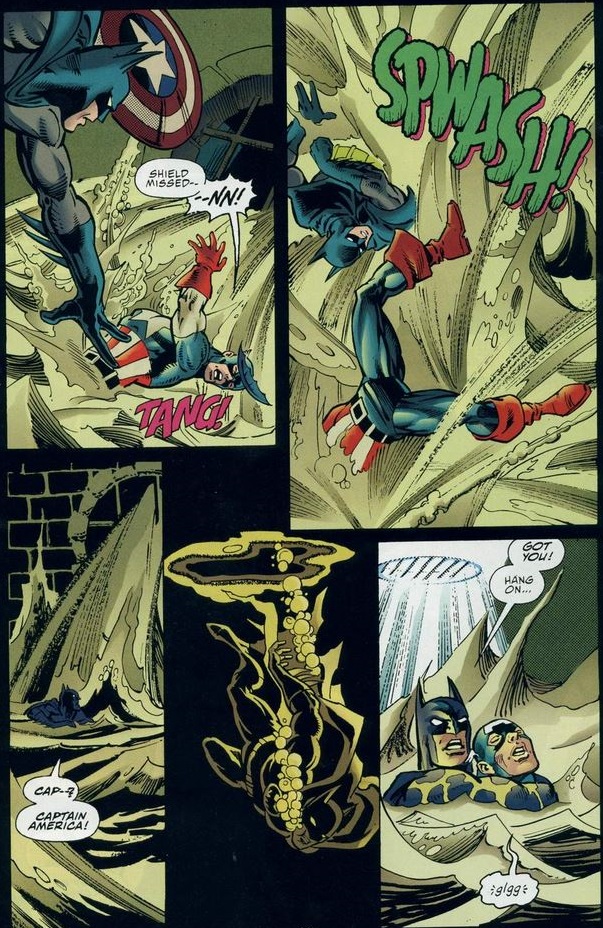
Nonetheless, Cap assumes that he lost and the battle is over… until they meet two “Keepers” named Axel Asher and Morty, humans containing shards of the Brothers and who guard the pathway between the two universes, helping to maintain the balance between them (or something like that).
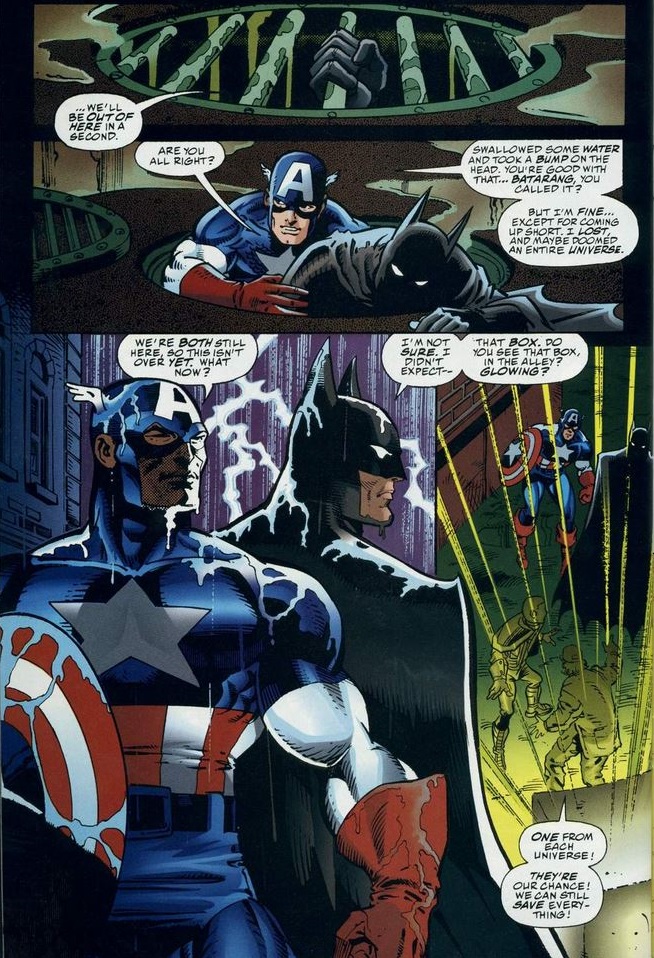
One of the Keepers lays hands on Cap and Batman and… oh no, something goes wrong…
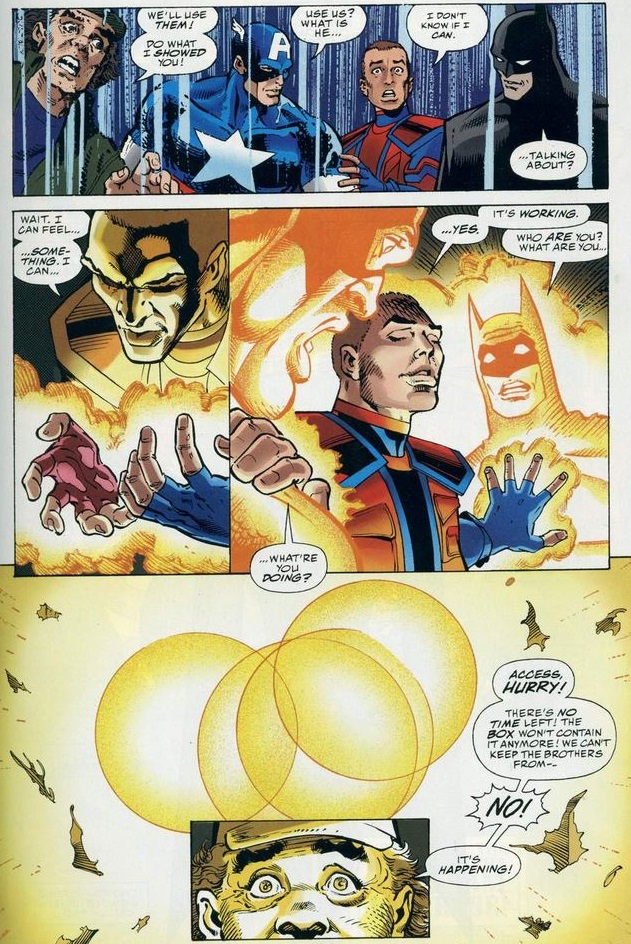
…and rather than saving one universe and destroying the other, the Brothers decide to merge the universes, creating the Amalgam Universe.

The Amalgam Universe consisted of a number of one-shots featuring the “new” characters above. Most notable for our purposes, Super Soldier #1 (April 1996), written by Mark Waid and penciled by Dave Gibbons, tells the tale of a young man named Clark Kent, who is given a super-soldier serum drawn from a dying alien, along with solar radiation, which gives him amazing powers to help the Allied Cause during World War II.

The comic ends with a clever letters page featuring many “familiar” names.
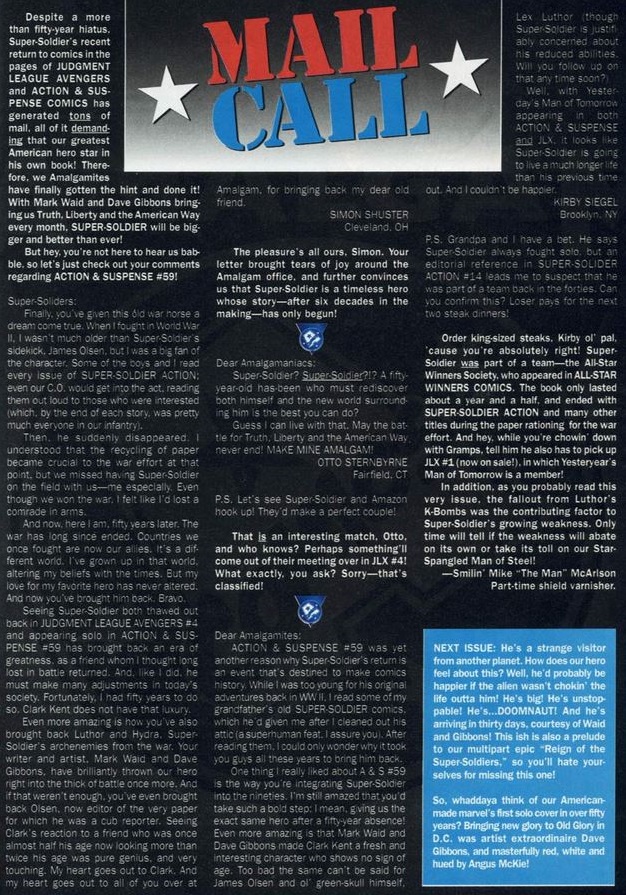
Back to issue #4 of the miniseries, Axel (also known as Access) separates the Amalgam Universe into the original two, with Batman and Cap tired of being used. (Just wait, fellas.)

Our heroes ask Axel what happened, but it doesn’t make any more sense to them than it does to us!

The heroes may not be, but the Brothers themselves start to battle, while the Spectre and the Living Tribunal look on, with the expected effects of both universes. Cap and Batman—the two “normal guys,” remember—decide to intervene, and despite his reservations, Axel agrees to give them a ride.

They all enter what Axel calls “a state of consciousness” in which they watch their own mental representations of the Brothers fight, with the Spectre and the Living Tribunal doing… well, nothing. (They’re the tiny folks hanging over to the Brothers’ swords.) But Batman and Cap realize that here, they have the only weapons they need: their incredible willpower.

Although we assume they could imagine themselves larger, they both approach the Brothers as they see themselves and try to reason with them…
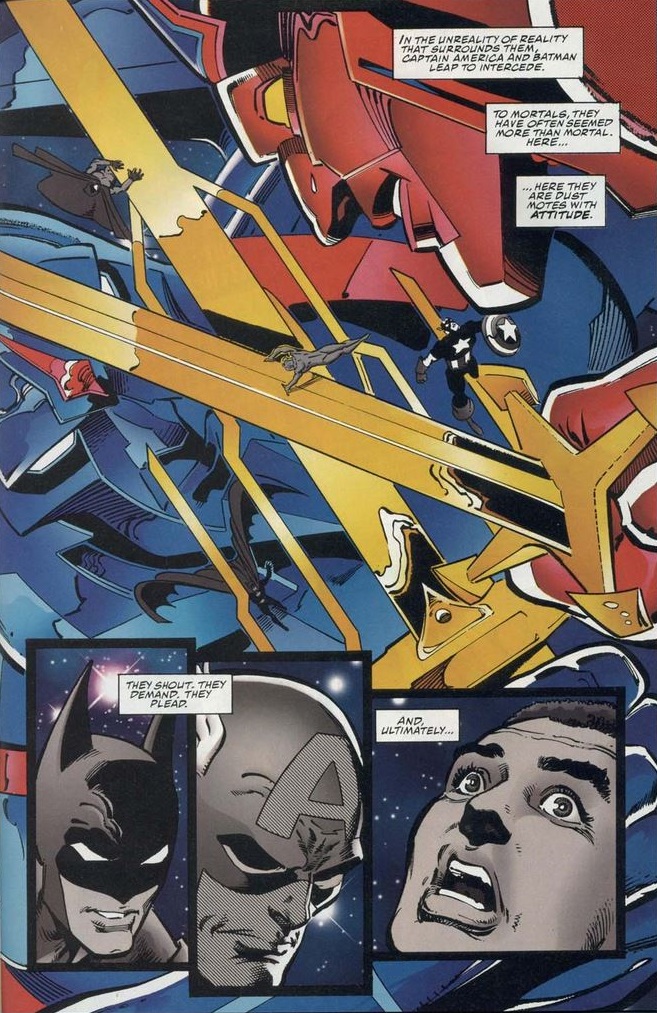
…but to no avail. As the Brothers threaten to destroy each other, they do even worse to Batman and Captain America, whose essences are revealed to them.

What follows are very brief summaries of each man’s history, motivation, and character—gee, someone oughta write a book or two—emphasizing that each man started from tragic or humble beginnings but became a hero among heroes…

…each “one among many” yet “forever unique.”

Out of their admiration for the two ordinary mortals and their shame at how small they look in comparison, the Brothers stop fighting, shake hands, and tell each other, “you’ve done well.” (I’m not kidding.)
With everyone back on their proper worlds, our heroes reflect on what happened, with Cap and Batman humbled as well, presumably by the enormity of what they have just experienced.
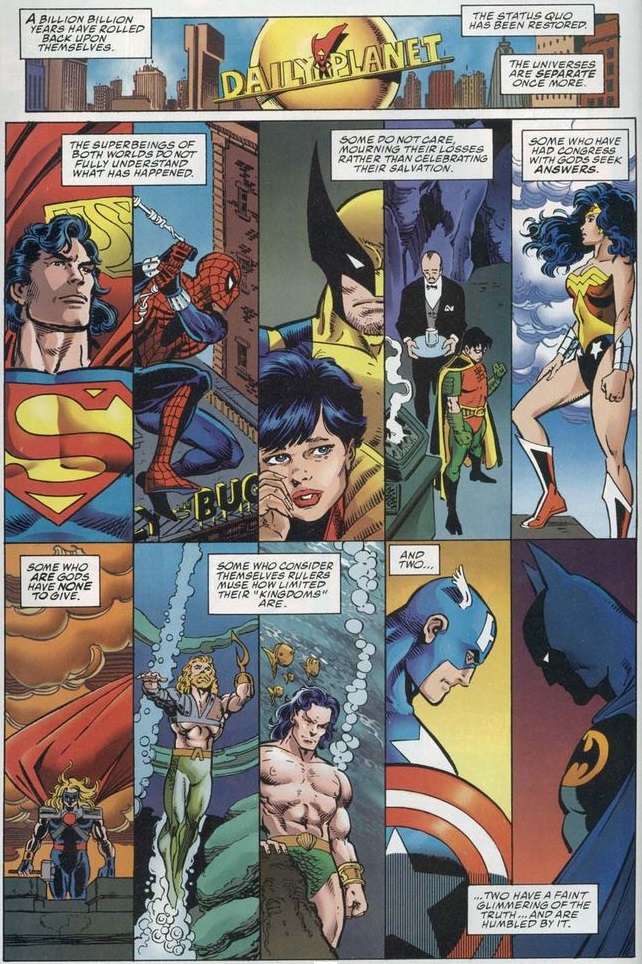
Before we finish, I just wanted to highlight a few panels with Wonder Woman, who, in the midst of fighting Storm, comes across a certain hammer…

…and wonders how anyone could determine what “worthy” means. (Right?)
Anyway, she picks up the hammer and is found worthy—and proves herself even more worthy when she drops it again, not wanting to win her contest unfairly.

Later, when Thor finds the hammer next to Wonder Woman, she casually hands it to him…
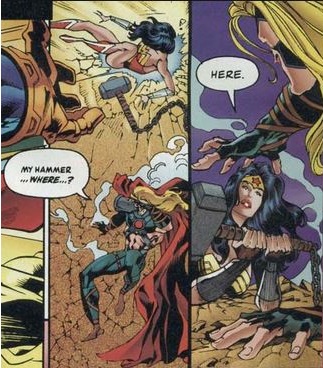
…leaving the God of Thunder at a loss for words!

ISSUE DETAILS
DC Versus Marvel #1, February 1996: Ron Marz and Peter David (writers), Dan Jurgens and Claudio Castellini (pencils), Josef Rubinstein and Paul Neary (inks), Gregory Wright and Digital Chameleon (colors), Bill Oakley (letters). (More details at Marvel Database.)
Marvel Versus DC #2, March 1996: Peter David (writer), Claudio Castellini and Dan Jurgens (pencils), Paul Neary and Josef Rubinstein (inks), Gregory Wright and Digital Chameleon (colors), Bill Oakley (letters). (More details at Marvel Database.)
Marvel Versus DC #3, April 1996: Ron Marz (writer), Dan Jurgens and Claudio Castellini (pencils), Josef Rubinstein and Paul Neary (inks), Gregory Wright and Digital Chameleon (colors), Bill Oakley (letters). (More details at Marvel Database.)
DC Versus Marvel #4, May 1996: Peter David (writer), Claudio Castellini and Dan Jurgens (pencils), Paul Neary and Josef Rubinstein (inks), Gregory Wright and Digital Chameleon (colors), Bill Oakley (letters). (More details at Marvel Database.)
Collected (with all the Amalgam issues) in DC Versus Marvel: The Amalgam Age Omnibus.
ALSO THESE MONTHS: Captain America #448 (February 1996), Avengers #395, Avengers: Timeslide #1, Iron Man #325, and Age of Innocence: The Rebirth of Iron Man #1 (February 1996), Captain America #449, Avengers #396, Iron Man #326, and Thor #496 (March 1996), Prime/Captain America #1 (March 1996), and Captain America #450-451 (April-May 1996)
Leave a comment